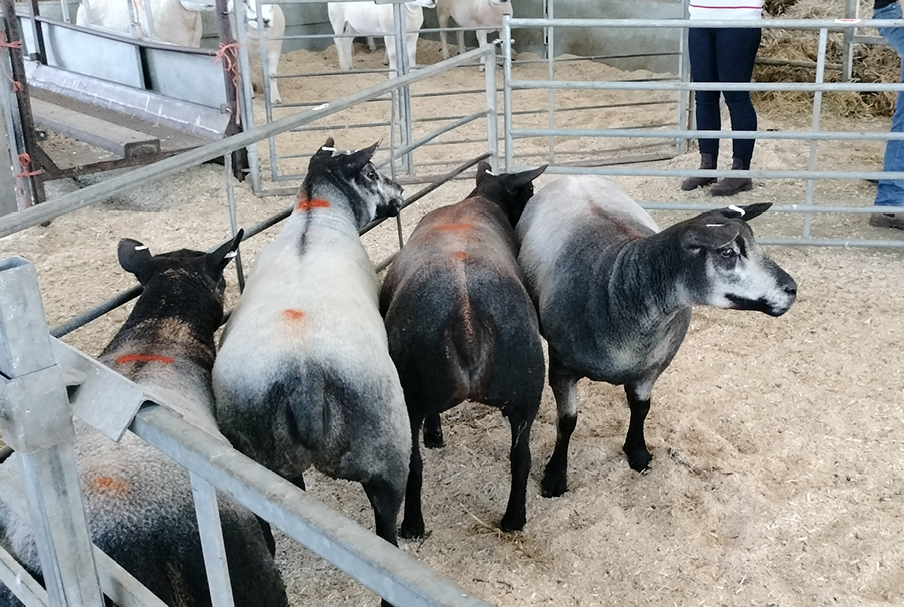My next stop was 40 minutes away still in Aberdeenshire to stay with Scott Dey, Vice Chair of West Deeside district. Scott shepherds across a couple of farms in the area, works in the yards of the livestock ships that come to Aberdeen from the Shetland and Orkney Islands as well as rents land to keep his flock of 150 Cheviot ewes which are bred to a blue-faced Leicester.
We managed to pack a fair bit into the three days I was with Scott, on the first night we attended a dance for the Deeside district 90th anniversary which was a fantastic night with a great band. It was a great way to meet people however with the loud music hearing people was hard enough let alone trying to understand a few thick Aberdeen accents!
We also went on a Distillery tour in the whisky famous Speyside area and we found our way to Glenallachie Distillery. We had a great sample of five of their various single malts after a look at their impressive still. Also getting a lesson on different casks, having a smell and look of old and new barrels used. From Spanish and American oak to casks having had Sherry, Bourbon and Red wine.
My last event with Scott was a stock judging training for those in the district competing in the Highland Show. We had three classes there to judge, first up some Blue Texel ewes which have a few features differing other than their colour to their more common cousin. For this, we had 5 minutes to judge our 1st to 4th order but didn't give reasons so we all read aloud our rankings before the judge revealed their pick. We followed the same process for four Texel tup (Ram) lambs, before having four Texel Gimmers (unlambed two-tooths) to judge and then present to a judge and timekeeper our reasons of order.

Unlike in NZ, we are taken away from beside the stock and come competition giving reasons may be quite some time after the judging so good notes are essential. I found out that local terminology is advised to avoid making the judges laugh. Lastly, we were given tips on 'The Demonstration' the top few from the judging then qualify to give a demonstration to the judges, where a single sheep or cattle beast will be in the ring. The contestant will give a hands-on speil on the breed and how true to type that particular animal is and where it lacks.
Although the stock judging is quite formal in competition and prestigious to get through to the top few let alone take out the title at the Highland Show, I was impressed by how many people were keen to just have a go and get tips from the judging coaches. It was a great evening and ran smoothly. It would be awesome to see the passion more so in NZ clubs and tournament stock judging.
The next morning I was off on my way to Edinburgh stopping in at a biogas digester, producing methane to go into the grid of natural gas used to heat homes up and down the country as a by-product of oil refinery.
The 4000 acre (1666ha) farm grows cereal crops on just under half of the land area to enter the market of distilling or pig/chicken feed. The majority of the land is used for growing sugar beet, whole-crop rye silage and grass pasture silage. All harvesting, cultivation and crop establishment are done in-house, the machinery was pretty impressive.
The Biodigester works the same as the stomach of a cow. Feed goes in it's heated up and mixed with water in a big 'stomach' where methanogen bacteria break down the plant matter and methane is released. There are 3 chambers to the digester, all extremely large tanks with a flexible diaphragm over the top to allow for expanding gas. The tanks can hold 40,000T of water/plant matter. 40,000T is also taken out of the digester, a solid form which looks somewhat between a very dark silage and a dry horse dung, which is phosphorus and potassium-rich. Also, a liquid which has high in nitrogen content. Both of these are spread back onto the paddocks to Increase soil fertility and organic matter.
As the production plant is of large enough scale, there is a cleaning plant on farm where the methane can be quality checked before going into the main grid work of pipelines. It was a fascinating visit and I thought it to be unfortunate that with NZ's lack of refinery facilities a shame that it's not a market to be easily tapped into.
Written by
NZ Young FarmersRelated articles
Keep reading other articles from the same authors and about the same topics.






